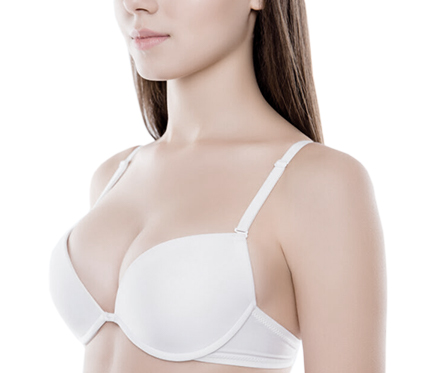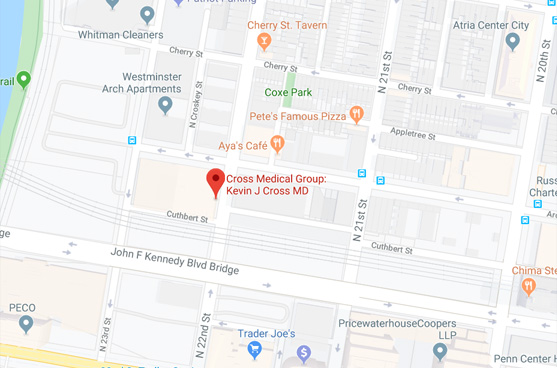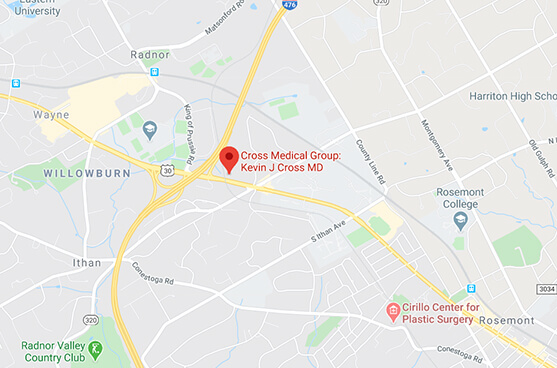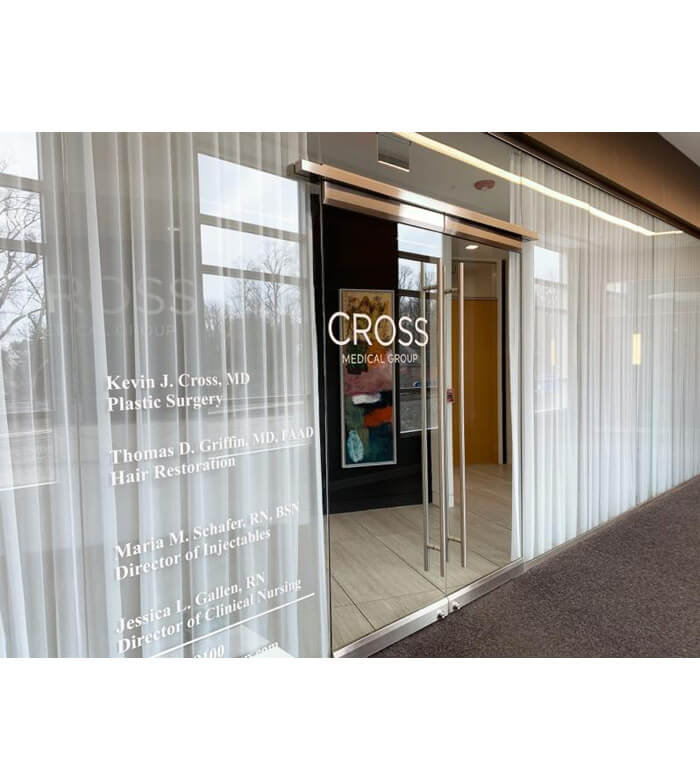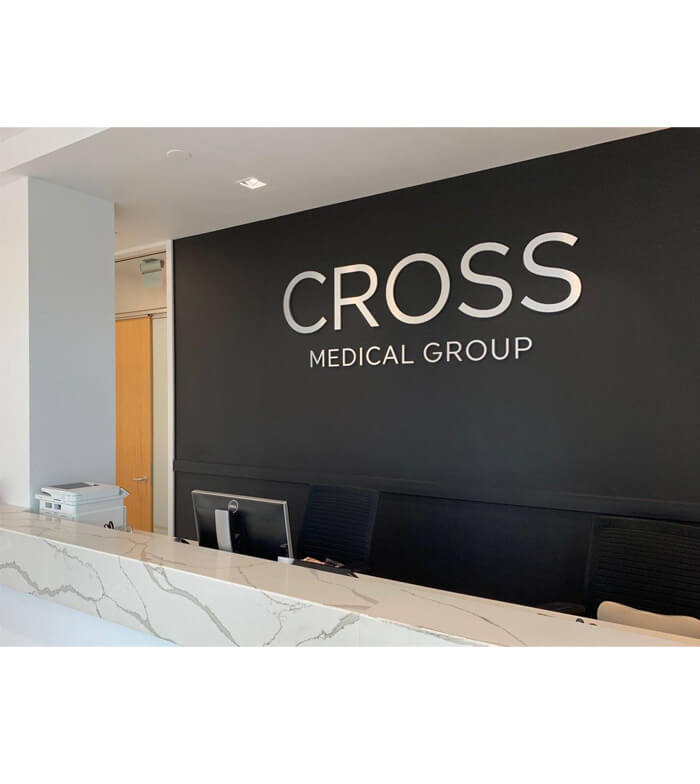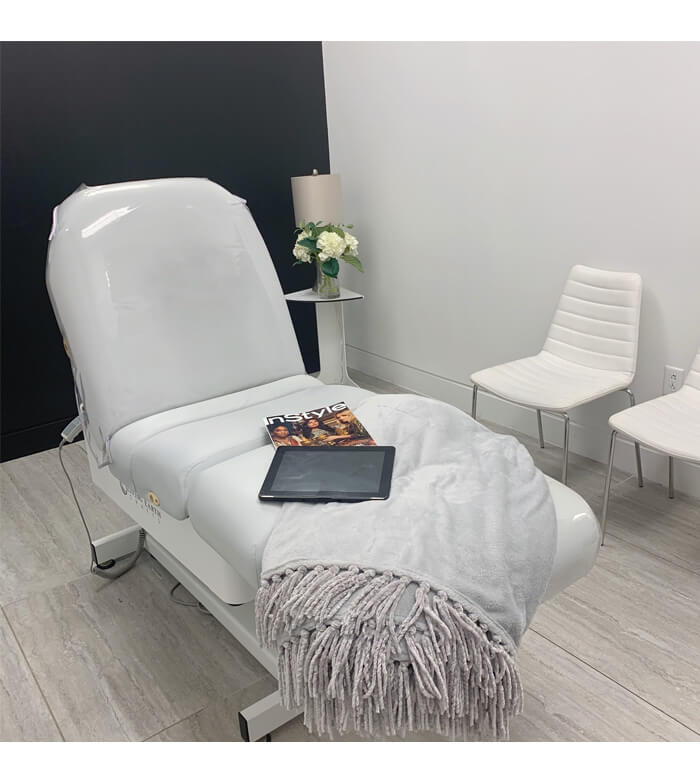BREAST AUGMENTATION
ENHANCE SIZE, SHAPE, SYMMETRY, AND MORE WITH BREAST IMPLANTS AND FAT TRANSFER
One of the most popular plastic surgery options available at Cross Medical Group is breast augmentation. The Philadelphia area's Dr. Kevin Cross and Dr. Jackie Lyons are highly experienced in the surgical procedure that provides a range of benefits for patients of all ages. Augmentation mammaplasty, as the procedure is technically known, can help everyone from moms who have seen breast changes develop after having children to younger women whose breasts have grown asymmetrically or out of proportion to their other features. The surgery is ideal for patients who have watched their chest “deflate” due to weight loss, age, or menopause.
Breast augmentation can help such a wide variety of people because of its own versatility. While the procedure was once limited to the insertion of breast implants, another technique—known as fat transfer, which moves fat cells from other parts of the body to the breasts—has developed in recent years. Today’s plastic surgeons can use implants and fat transfer alone or in combination to help patients achieve truly customized and beautifully natural-looking results.
BREAST AUGMENTATION DETAILS
Breast augmentation surgery is most often performed as an outpatient procedure that typically takes about one to two hours. The Cross Medical Group team uses a recently developed protocol that decreases a patient’s chance of experiencing nausea after the procedure. This protocol also helps patients to recover more rapidly from the anesthesia used during the surgery. A return to work after a few days is possible, and many patients resume their regular exercise routine and daily activities just two weeks after their procedure.
If Dr. Cross or Dr. Lyons are using breast implants, they will make small incisions in a location where the eventual scars will be as imperceptible as possible. The incisions themselves are typically not much longer than the width of two fingers, so they are difficult to notice anyway.
After positioning the implants above or below the chest muscle— depending on the specifics of the procedure—they will then close the incisions.
If fat grafting is also part of the breast augmentation surgery, Dr. Cross or Dr. Lyons will meticulously remove fat cells from an ample donor area on the body—such as the buttocks or thighs—then process these cells to purify them. Once processed, the fat cells will be strategically injected into the breasts to add volume while maintaining or even creating a natural shape and appearance. The fat cells must be handled with great care, since they need to remain intact and alive in order to re-connect to the body's blood supply when injected for breast augmentation.
Thanks to Dr. Cross’ and Dr. Lyons’ careful and advanced surgical techniques, patients generally experience only minimal to moderate pain after their breast augmentation surgery. For patients who have a breast implant placed under the chest muscles, their chest itself will likely feel tight for a few days as the body adjusts to the presence of the silicone shell.
BREAST IMPLANT OPTIONS
Patients opting for breast implants have numerous combinations of shapes and sizes to choose from. The most common implants used for breast augmentation in United States are smooth, round, and filled with silicone. Dr. Cross and Dr. Lyons regularly work with these silicone breast implants, but they also use saline implants for a large number of their patients. The choice depends on patient’s unique anatomy and goals.
For example, since saline implants can be inserted empty and filled once in place, they are ideal for patients who want their incisions to be as small as possible. Other patients believe that silicone implants feel the most like actual breast tissue, so they prefer this option. All of this can be discussed at a personalized consultation.
From the 1990s to the mid-2000s, the FDA enacted a ban on silicone-filled breast implants due to concern that the silicone inside was causing strange, autoimmune-like symptoms in breast augmentation patients. During that widow of time, saline-filled implants were the only option available for patients who wanted breast augmentation.
Since then, studies on thousands of women—those with silicone-filled implants, those with saline-filled implants, and those with no breast implants at all—revealed that there was no association between the implants and the symptoms being investigated. After those findings were reported, silicone implants became available once again as of 2006.
BREAST AUGMENTATION AND PATIENT SATISFACTION
Dr. Kevin Cross and Dr. Jackie Lyons both have a goal of maximizing patient satisfaction, so they take choosing the right size and dimension of breast implant very seriously. Patients will work closely with them throughout the meticulous process of selecting the ideal implant. This starts with a thorough discussion during your initial consultation, which helps them to get a clear picture of your aesthetic desires. After this, they will conduct a physical examination that includes taking measurements of the breasts and other features. They will also take scans for the Vectra Imaging System, which creates three-dimensional images that allow patients to see what their body could realistically look like after the surgery. Access to various types of simulated implants allow you "try on" different sizes and explore other variables in order to more easily envision your ultimate ideal look.
Dr. Cross and Dr. Lyons also use the consultation as an opportunity to present breast augmentation before-and-after photos, all chosen to reveal images of patients with a similar body type and cosmetic goals to the patient. While reviewing these breast augmentation before-and-after photos, patients will be able to see real-world examples of the results of surgery at Cross Medical Group.
SCHEDULE A CONSULTATION
Schedule a breast augmentation consultation today by calling Cross Medical Group at (215) 561-9100 (Philadelphia) or (610) 688-9100 (Villanova), or send a message online.
BREAST AUGMENTATION IMPLANT PLACEMENT
Patients choosing breast augmentation with implants will work with Dr. Cross and Dr. Lyons to determine where the implant will be positioned. The implant will either sit directly under a patient's natural breast tissue (a technique known as subglandular placement) or under the pectoralis major muscle, which is the predominant chest muscle (this is known as submuscular placement).
Both options offer unique benefits, so Dr. Kevin Cross and Dr. Jackie Lyons work closely with their patients to determine the ideal placement for each individual.
Positioning the implant above the muscle helps the implant to better define the breast shape, since it is more visible. This approach can be ideal for breast augmentation patients who have poor natural breast shape. The placement also prevents chest muscle contractions and movements from impacting the movement of the implants.
Positioning a breast implant under the pectoralis muscle helps to “camouflage” the implant by obscuring the edges, which can be important for patients who have very little of their own natural breast tissue to cover the outline of the device. This placement also makes future testing for breast cancer easier in high-risk patients, since the implant is below the muscle and will not be “in the way” of any screenings.
In order to insert the implants during a breast augmentation surgery, Dr. Cross and Dr. Lyons make small incisions that may be hidden in the lower fold of the breast, camouflaged in the line where the darker pigment of the areola meets the lighter skin of the breast, or made in the armpit, some distance away from the breast itself. The underarm approach avoids incisions and scarring on the breasts themselves.
While each of these incision strategies offers unique advantages, and certain patients may benefit from one more than the others, siting the incision in the under-folds of the breasts is typically the approach that maximizes the most stable and precise results.
Patients who want to address sagging or drooping breasts in addition to adding volume should know that a combination procedure has benefits of its own. If a breast lift is being performed at the same time as the breast augmentation, the incision made for the lift can also be used for the implant insertion.
POST-CHILDBIRTH BREAST AUGMENTATION
While all breast augmentation surgeries are fundamentally the same in that they add volume to the breasts, Dr. Kevin Cross and Dr. Jackie Lyons treat post-childbirth breast augmentation as its own separate procedure. This is because pregnancy and breastfeeding alter the physical makeup and appearance of the breasts in ways that require specific solutions and strategies when it comes to surgery.
Restoring shape and balance to breasts via post-childbirth breast augmentation presents a unique set of challenges. A rapid increase in breast size due to the formation of glandular tissue and other changes during lactation stretches the skin and ligaments of the breast in a way that keeps the breast from ever returning to its pre-pregnancy shape. Breasts also often lose—or, less often, gain—volume after childbirth and breastfeeding are over.
Some patients find that a lift, augmentation, or reduction alone is enough of a procedure to restore proper shape to their breast, but others seeking restoration often require a combination of breast lift and the introduction of volume via the insertion of breast implants, fat transfer, or both. Breast reduction can also be used to shape the breasts.
Deciding which combination of these strategies and techniques is going to provide the best long-term results for a particular patient is an important part of the consultation with Dr. Cross or Dr. Lyons, as well as the overall planning process that takes place before any breast augmentation at the Philadelphia area's Cross Medical Group.

*Results May Vary
Before & After Photo Gallery
See for yourself the patient transformations that can be achieved by Dr. Cross, Dr. Lyons, and their team.
LIFE AFTER BREAST AUGMENTATION
Implants can impact breast mammography, especially since it has been established that a portion of an enhanced breast is harder to visualize with a mammogram. Because of this, patients who have breast implants inserted must undergo specialized mammographic images, known as Eklund views. That said, patients should know that a study comparing thousands of women—those with implants and those without implants—found no significant difference between the two groups when it came to rates of breast cancer diagnosis, the time at which cancer was diagnosed, or the risk of mortality due to breast cancer.
In the same way, a study into breastfeeding after breast augmentation with implants showed that although breast milk in patients with implants may contain trace amounts of silicone, the levels are significantly less than the levels of silicone found in both infant formula and bottled milk. While breast augmentation may affect some patients’ ability to produce milk, it appears that women who want to breastfeed are able to do so—though small studies show that some may require supplementation, just like women without breast implants who attempt to breastfeed.
Ultimately, breast augmentation remains an ideal way to create or restore balance and shape to an area patients cannot change on their own, allowing them to feel more comfortable with their proportions and appearance.
SURGICAL OPTIONS BEYOND BREAST AUGMENTATION
Breast augmentation is just one of the breast surgery procedures available at Cross Medical Group. In addition to breast enlargement, Dr. Kevin Cross and Dr. Jackie Lyons also offer breast reductions for patients who want to reduce volume, as well as gynecomastia surgery for men seeking to address the unwanted development of breast tissue and appearance of breasts.
Breast augmentation surgery may also be part of a Mommy Makeover, which is the term for a suite of procedures combined to bring a patient’s proportions, shapes, and curves more in line with the look of their pre-pregnancy body. Potential Mommy Makeover components include fat-reducing liposuction, belly-flattening tummy tuck surgery, and other procedures and nonsurgical treatments.
SCHEDULE A CONSULTATION
Contact Cross Aesthetics for breast augmentation in Philadelphia (215) 561-9100 or Main Line's Villanova (610) 688-9100. You can also send a message online to inquire about a consultation with Dr. Kevin Cross or Dr. Jackie Lyons, or for more information.


